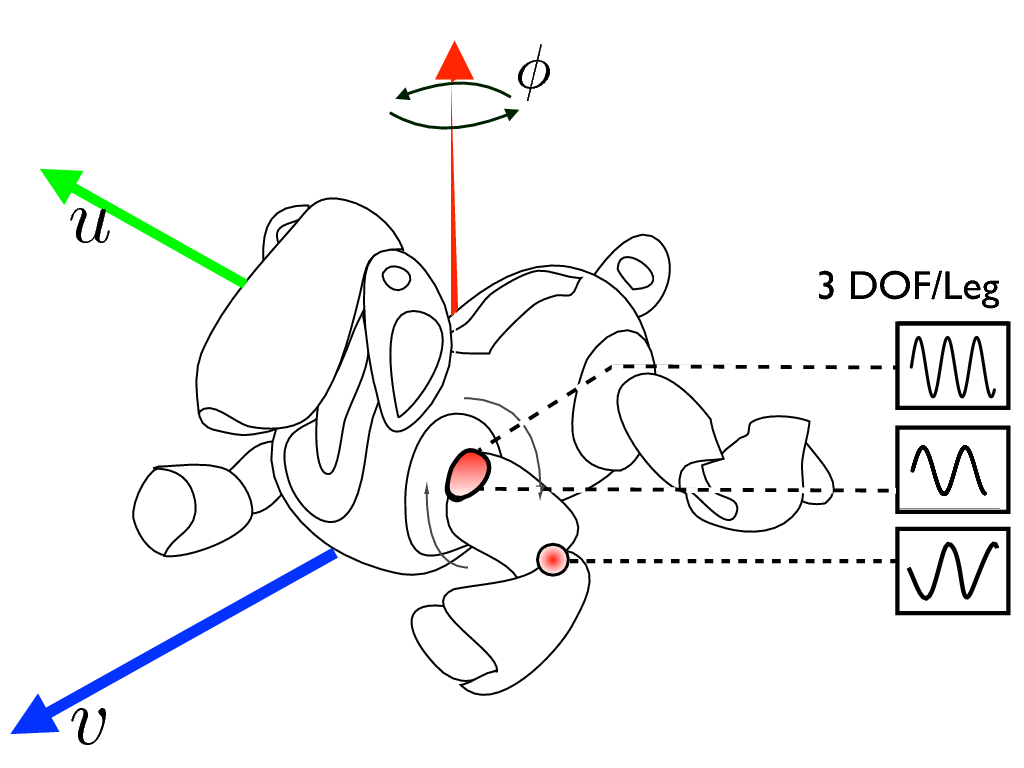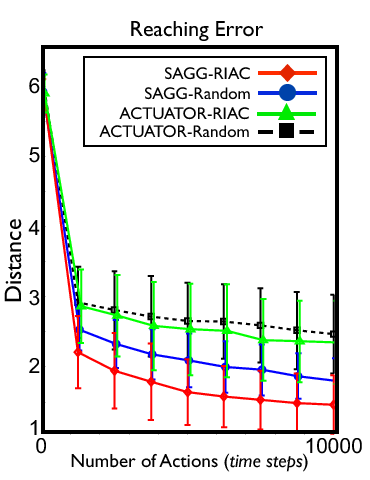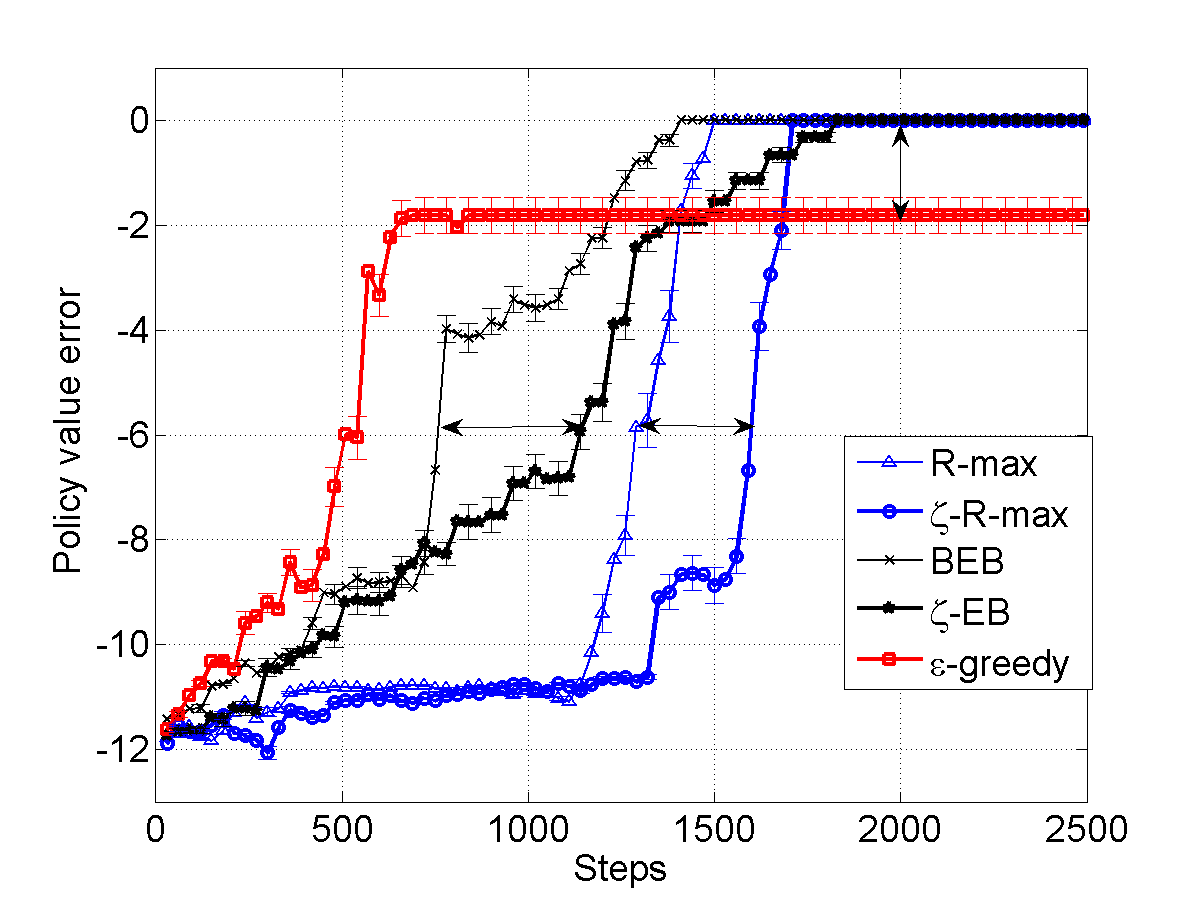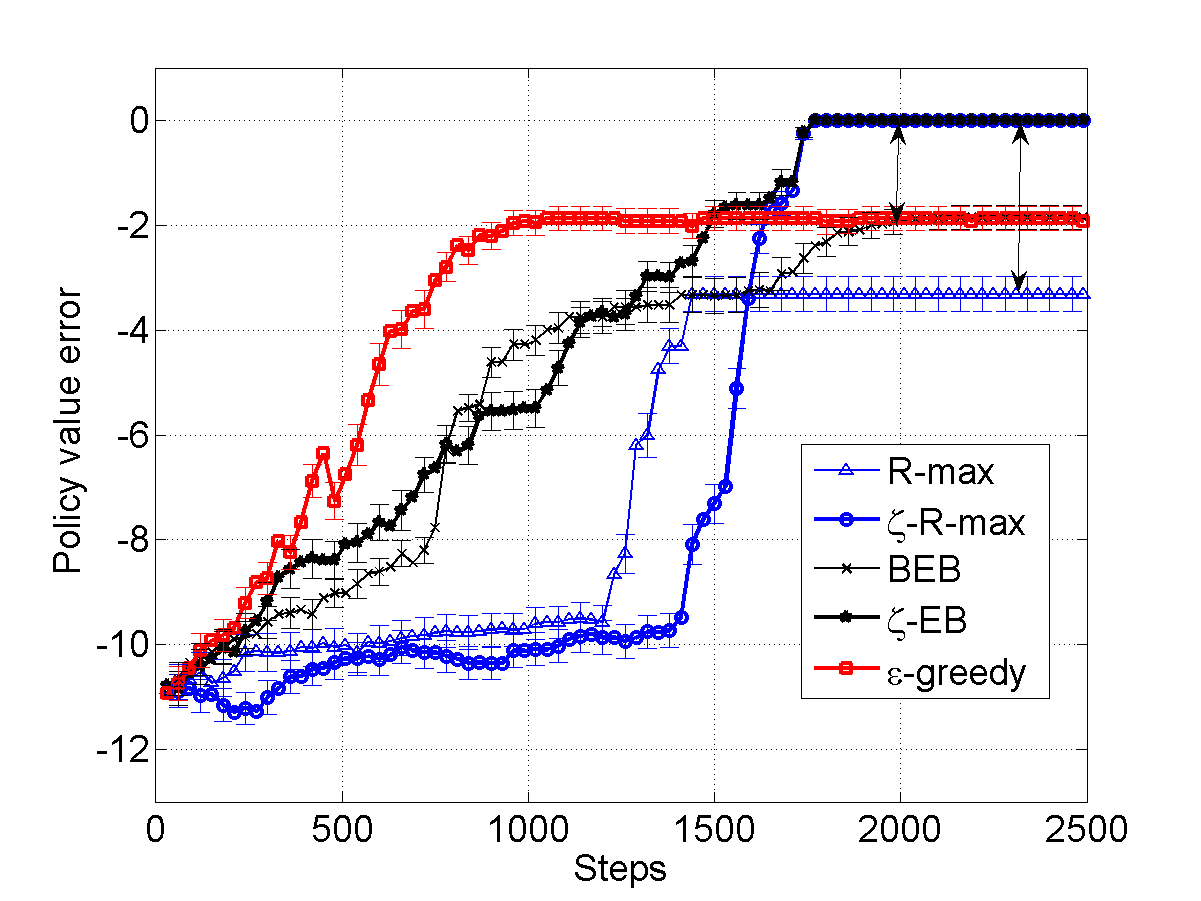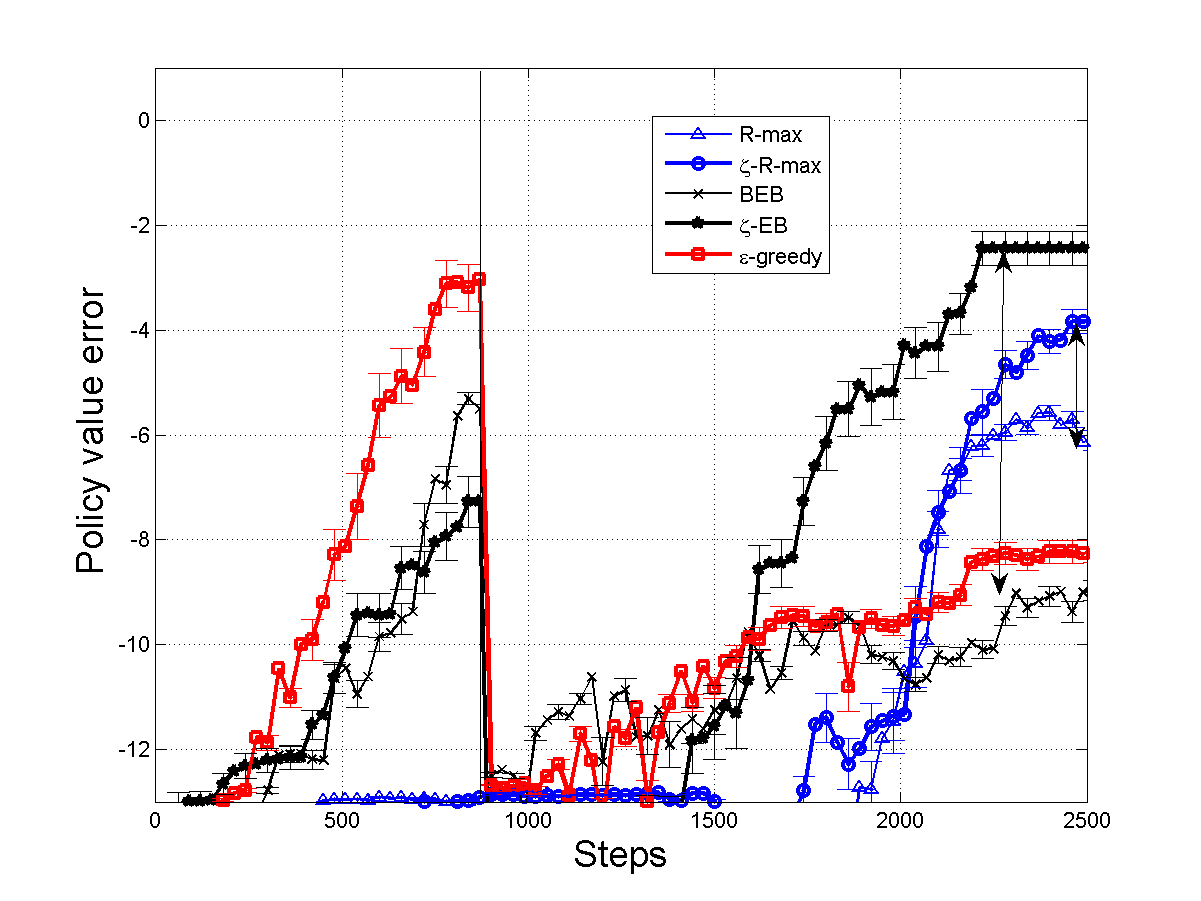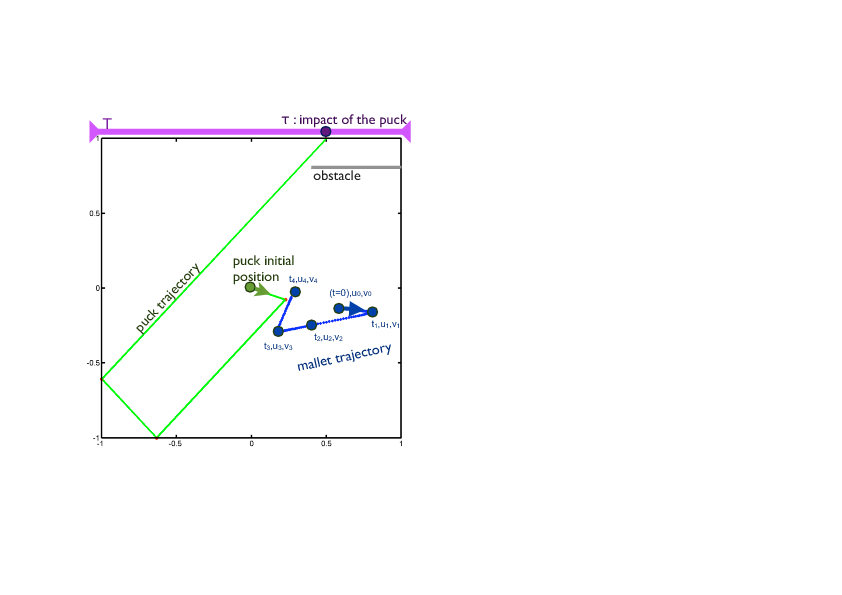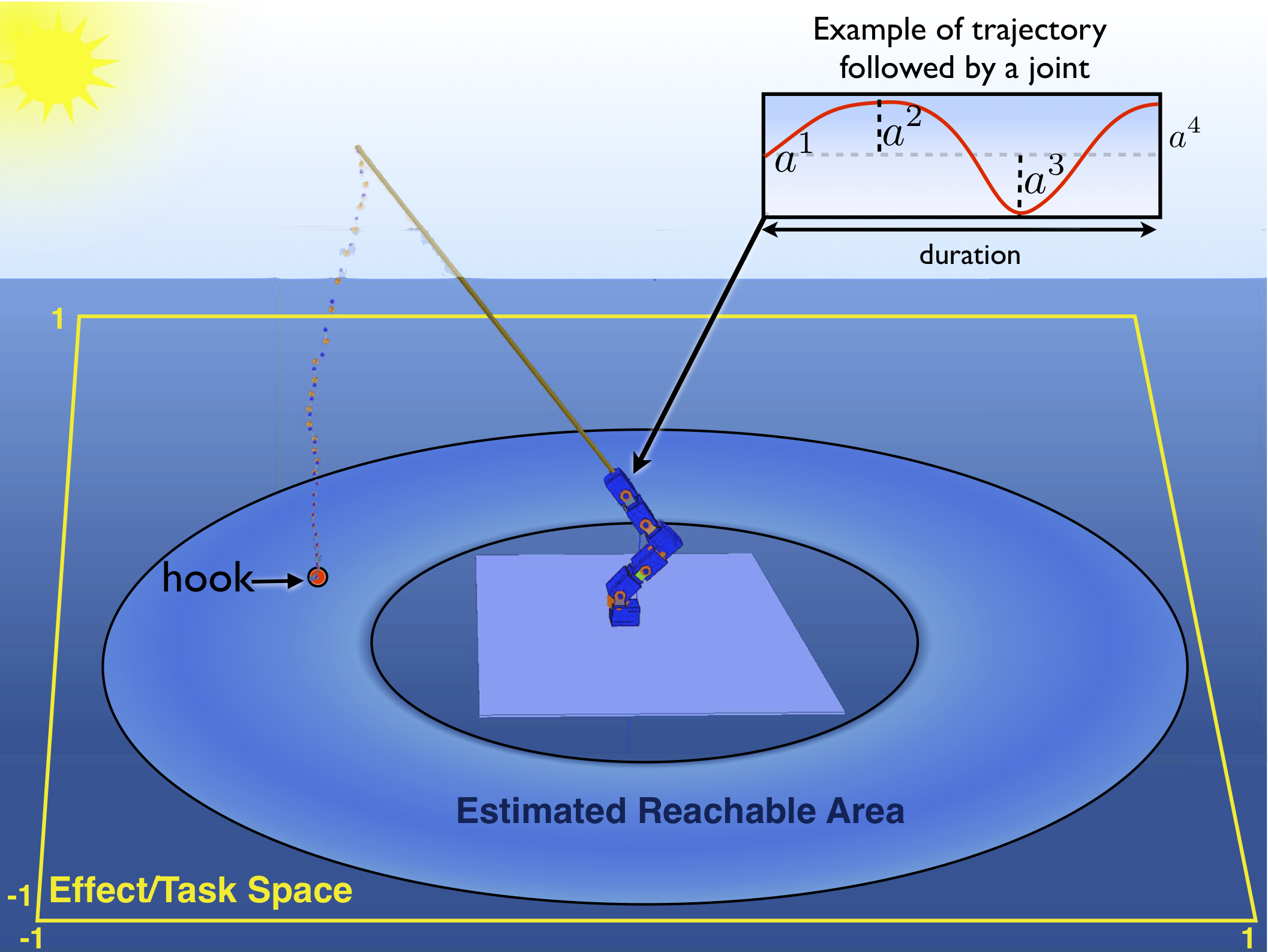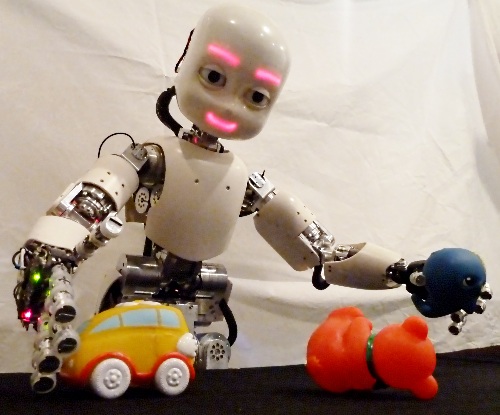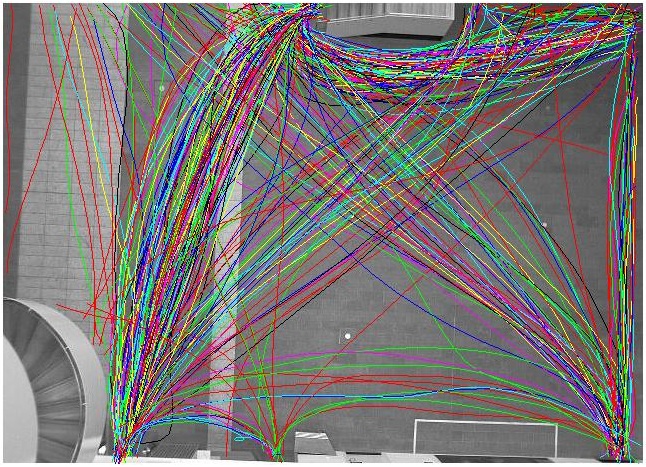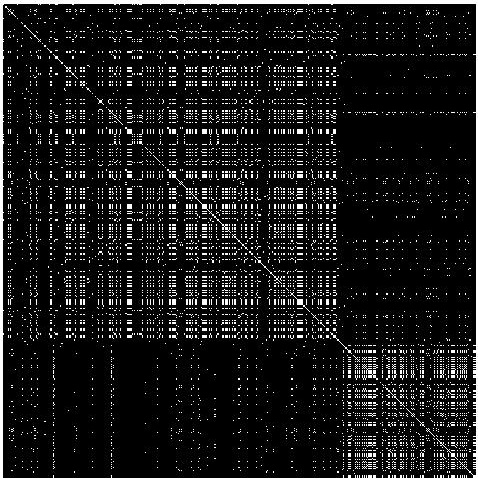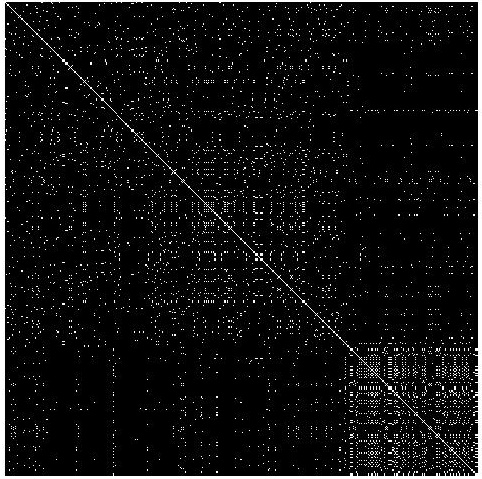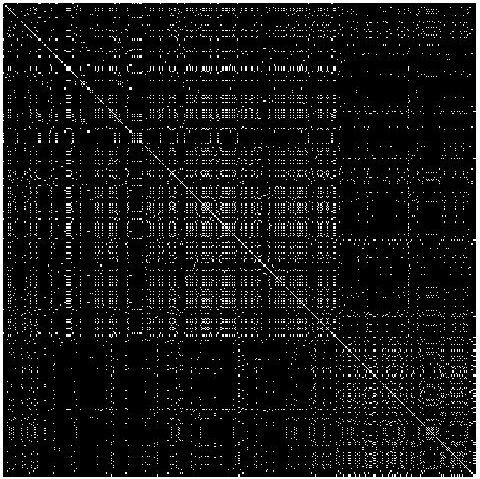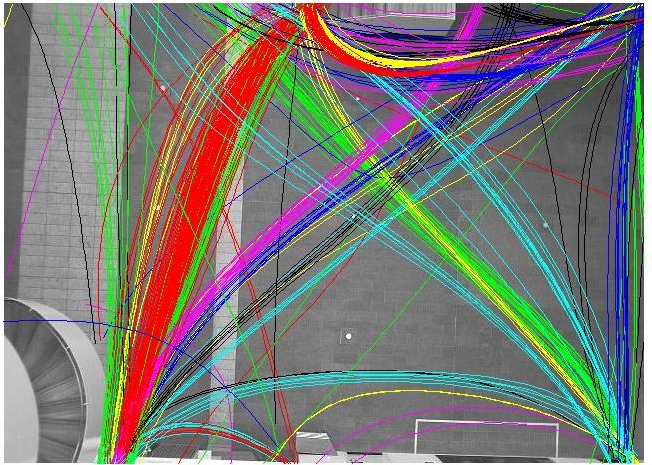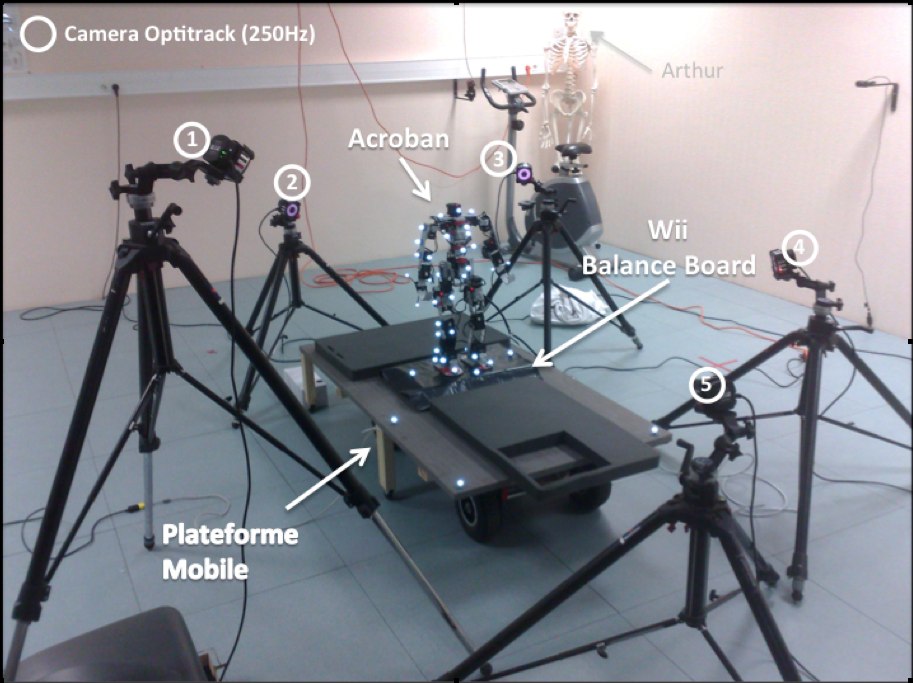Section: New Results
Autonomous and Social Skill Learning and Development
Active Learning and Intrinsic Motivation
Active Learning of Inverse Models with Goal Babbling
Participants : Adrien Baranes, Pierre-Yves Oudeyer.
We have continued to elaborate and study our Self-Adaptive Goal Generation - Robust Intelligent Adaptive Curiosity (SAGG-RIAC) architecture as an intrinsically motivated goal exploration mechanism which allows active learning of inverse models in high-dimensional redundant robots. Based on active goal babbling, this allows a robot to efficiently and actively learn distributions of parameterized motor skills/policies that solve a corresponding distribution of parameterized tasks/goals. The architecture makes the robot sample actively novel parameterized tasks in the task space, based on a measure of competence progress, each of which triggers low-level goal-directed learning of the motor policy parameters that allow to solve it. For both learning and generalization, the system leverages regression techniques which allow to infer the motor policy parameters corresponding to a given novel parameterized task, and based on the previously learnt correspondences between policy and task parameters.
We have conducted experiments with high-dimensional continuous sensorimotor spaces in three different robotic setups: 1) learning the inverse kinematics in a highly-redundant robotic arm, 2) learning omnidirectional locomotion with motor primitives in a quadruped robot 17 18 , 3) an arm learning to control a fishing rod with a flexible wire. We show that 1) exploration in the task space can be a lot faster than exploration in the actuator space for learning inverse models in redundant robots; 2) selecting goals maximizing competence progress creates developmental trajectories driving the robot to progressively focus on tasks of increasing complexity and is statistically significantly more efficient than selecting tasks randomly, as well as more efficient than different standard active motor babbling methods; 3) this architecture allows the robot to actively discover which parts of its task space it can learn to reach and which part it cannot.
This work was published in the journal Robotics and Autonomous Systems [22] .
|
|
Exploration in Model-based Reinforcement Learning
Participants : Manuel Lopes, Tobias Lang, Marc Toussaint, Todd Hester, Peter Stone, Pierre-Yves Oudeyer.
Formal exploration approaches in model-based reinforcement learning estimate the accuracy of the currently learned model without consideration of the empirical prediction error. For example, PAC-MDP approaches such as R-MAX base their model certainty on the amount of collected data, while Bayesian approaches assume a prior over the transition dynamics. We propose extensions to such approaches which drive exploration solely based on empirical estimates of the learner's accuracy and learning progress. We provide a ”sanity check” theoretical analysis, discussing the behavior of our extensions in the standard stationary finite state-action case. We then provide experimental studies demonstrating the robustness of these exploration measures in cases of non-stationary environments or where original approaches are misled by wrong domain assumptions. [46] . Furthermore, we studied how different exploration algorithms can be combine and selected at runtime. Typically the user must hand-tune exploration parameters for each different domain and/or algorithm that they are using. We introduced an algorithm called leo for learning to select among different exploration strategies on-line. This algorithm makes use of bandit-type algorithms to adaptively select exploration strategies based on the rewards received when following them. We show empirically that this method performs well across a set of five domains In contrast, for a given algorithm, no set of parameters is best across all domains. Our results demonstrate that the leo algorithm successfully learns the best exploration strategies on-line, increasing the received reward over static parameterizations of exploration and reducing the need for hand-tuning exploration parameters [42] .
| ||||
|
The Strategic Student Approach for Life-Long Exploration and Learning
Participants : Manuel LOPES, Pierre-Yves OUDEYER.
We introduced and formalized a general class of learning problems for which a developmental learning strategy is shown to be optimal. This class of problems can be explained using the strategic student metaphor: a student has to learn a number of topics (or tasks) to maximize its mean score, and has to choose strategically how to allocate its time among the topics and/or which learning method to use for a given topic. We show that if the performance curves are sub-modular, then a strategy where time allocation or learning method are chosen in a developmental manner is optimal. We argue that this optimal developmental trajectory can be automatically generated by greedy maximization of learning progress. This optimal strategy amounts to creating a structured developmental exploration where typically easy tasks are first explored, and then progressively more complicated ones are explored. Furthermore, this result holds independently of the nature of the topics and the learning methods used. Then, we show an algorithm, based on multi-armed bandit techniques, that allows empirical online evaluation of learning progress and approximates the optimal solution. Finally, we show that the strategic student problem formulation allows to view in a common framework many previous approaches to active and developmental learning [47] .
Active Inverse Reinforcement Learning through Generalized Binary Search
Participants : Manuel Lopes, Francisco Melo.
We contributed the first aggressive active learning algorithm for nonseparable multi-class classification. We generalize an existing active learning algorithm for binary classification [107] to the multi-class setting, and identify mild conditions under which the proposed method provably retains the main properties of the original algorithm, namely consistency and sample complexity. In particular, we show that, in the binary case, our method reduces to the original algorithm of [107] . We then contribute an extension of our method to multi-label settings, identify its main properties and discuss richer querying strategies. We conclude the paper with two illustrative application examples. The first application features a standard text-classification problem. The second application scenario features a learning from demonstration setting. In both cases we demonstrate the advantage of our active sampling approach against random sampling. We also discuss the performance of the proposed approach in terms of the derived theoretical bounds.
Towards high-dimensional and cumulative task space active exploration
Participant : Benureau Fabien.
One direction of research of the team has been on intrinsic motivation in the context of autonomous learning. Building on the PhD work of Adrien Baranes, the efforts have concentrated on creating algorithms capable to handle high-dimensional spaces and manage context with multiple tasks. The goal is for the learner to be able to autonomously create collection of reusable skills. In this context, two main research efforts have been led this year.
A typical robot is made of chains of joints. We can take advantage of the fact that joints earlier in the chain have more impact that joints further down. Given sensory feedback on the middle of the chain, an algorithm can use this information to boost learning speed and divide the learning space in subsets of smaller dimensions. We wanted to adapt this idea to high dimensional space, and specifically to the interaction with objects; a robotic arm that has already learned an inverse model of its kinematic could reuse this knowledge learn about the mapping between the position of the end-effector and the displacement of an object it is manipulating. Experiments were conducted, but they lead to the conclusion that such an approach, while effective in some specific setting, relies too heavily on a good representation of the end effector position and motion, which, in some cases, requires sensory space of higher dimension that the motor space, thus defeating the purpose. This approach was not found to be robust enough for the type of robotic context our lab is pursuing.
The SAGG-RIAC architecture is an efficient but complex architecture which implementation cannot be easily summarized in a few lines of pseudo-code. This is problematic because it reduces the ability of other research groups to implement and reuse our algorithms for their own work. An effort was started this year to create an implementation of SAGG-RIAC that would be more robust and simpler. The main idea was to use kernels rather than bins to estimate in interest in SAGG-RIAC. This approach led to very promising results, notably in its ability to handle unbounded sensory spaces. We aim at publishing the result of this work in 2013, together with a publicly available implementation of our algorithms with easy to run examples for dissemination of active learning architectures elaborated in the team. This work will also be reused in the participation of the lab into the MaCSi project.
Learning and optimization of motor policies
Off-Policy Actor-Critic
Participants : Thomas Degris, Martha White, Richard Sutton.
Actor–critic architectures are an interesting candidate for learning with robots: they can represent complex stochastic policies suitable for robots, they can learn online and incrementally and their per-time-step complexity scales linearly with the number of learned weights. Moreover, interesting connections have been identified in the existing literature with neuroscience. Until recently, however, practical actor–critic methods have been restricted to the on-policy setting, in which the agent learns only about the policy it is executing.
In an off-policy setting, on the other hand, an agent learns about a policy or policies different from the one it is executing. Off-policy methods have a wider range of applications and learning possibilities. Unlike on-policy methods, off-policy methods are able to, for example, learn about an optimal policy while executing an exploratory policy, learn from demonstration, and learn multiple tasks in parallel from a single sensory-motor interaction with an environment. Because of this generality, off-policy methods are of great interest in many application domains.
We have presented the first actor-critic algorithm for off-policy reinforcement learning. Our algorithm is online and incremental, and its per-time-step complexity scales linearly with the number of learned weights. We have derived an incremental, linear time and space complexity algorithm that includes eligibility traces and empirically show better or comparable performance to existing algorithms on standard reinforcement-learning benchmark problems. This work was presented by Degris et al. [38] and was reproduced independently by Saminda Abeyruwan from the University of Miami.
Auto-Actor Critic
Participant : Thomas Degris.
As mentioned above, actor–critic architectures are an interesting candidate for robots to learn new skills in unknown and changing environments. However, existing actor–critic architectures, as many machine learning algorithms, require manual tuning of different parameters to work in the real world. To be able to systematize and scale-up skill learning on a robot, learning algorithms need to be robust to their parameters. The Flowers team has been working on making existing actor–critic algorithms more robust to make them suitable to a robotic setting. Results on standard reinforcement learning benchmarks are encouraging. This work will be submitted to international conference related with reinforcement learning. Interestingly, the methods developed in this work also offer a new formalism to think about different existing themes of Flowers research such as curiosity and maturational constraints.
Relationship between Black-Box Optimization and Reinforcement Learning
Participant : Freek Stulp.
Policy improvement methods seek to optimize the parameters of a policy with respect to a utility function. There are two main approaches to performing this optimization: reinforcement learning (RL) and black-box optimization (BBO). In recent years, benchmark comparisons between RL and BBO have been made, and there has been several attempts to specify which approach works best for which types of problem classes.
We have made several contributions to this line of research by: 1) Defining four algorithmic properties that further clarify the relationship between RL and BBO. 2) Showing how the derivation of ever more powerful RL algorithms displays a trend towards BBO. 3) Continuing this trend by applying two modifications to the state-of-the-art algorithm, which yields an algorithm we denote . We show that is a BBO algorithm, and, more specifically, that it is a special case of the state-of-the-art CMAES algorithm. 4) Demonstrating that the simpler achieves similar or better performance than on several evaluation tasks. 5) Analyzing why BBO outperforms RL on these tasks. These contributions have been published on HAL [69] , and have been submitted to JMLR.
This work has also resulted in the novel -CMA, -CMAES algorithms, which are presented in [63] , [60] , [62]
Reinforcement Learning with Sequences of Motion Primitives for Robust Manipulation
Participant : Freek Stulp.
Physical contact events often allow a natural decomposition of manipulation tasks into action phases and subgoals. Within the motion primitive paradigm, each action phase corresponds to a motion primitive, and the subgoals correspond to the goal parameters of these primitives. Current state-of-the-art reinforcement learning algorithms are able to efficiently and robustly optimize the parameters of motion primitives in very high-dimensional problems. These algorithms often consider only shape parameters, which determine the trajectory between the start- and end-point of the movement. In manipulation, however, it is also crucial to optimize the goal parameters, which represent the subgoals between the motion primitives. We therefore extend the policy improvement with path integrals (PI) algorithm to simultaneously optimize shape and goal parameters. Applying simultaneous shape and goal learning to sequences of motion primitives leads to the novel algorithm PI-Seq. We use our methods to address a fundamental challenge in manipulation: improving the robustness of everyday pick-and-place tasks. This work was published in IEEE Transactions on Robotics [31] and Robotics and Autonomous Systems [26] .
Model-free Reinforcement Learning of Impedance Control in Stochastic Environments
Participant : Freek Stulp.
For humans and robots, variable impedance control is an essential component for ensuring robust and safe physical interaction with the environment. Humans learn to adapt their impedance to specific tasks and environments; a capability which we continually develop and improve until we are well into our twenties. We have reproduced functionally interesting aspects of learning impedance control in humans on a simulated robot platform.
As demonstrated in numerous force field tasks, humans combine two strategies to adapt their impedance to perturbations, thereby minimizing position error and energy consumption: 1) if perturbations are unpredictable, subjects increase their impedance through co-contraction; 2) if perturbations are predictable, subjects learn a feed-forward command to offset the perturbation. We show how a 7-DOF simulated robot demonstrates similar behavior with our model-free reinforcement learning algorithm , by applying deterministic and stochastic force fields to the robot's end-effector. We show the qualitative similarity between the robot and human movements.
Our results provide a biologically plausible approach to learning appropriate impedances purely from experience, without requiring a model of either body or environment dynamics. Not requiring models also facilitates autonomous development for robots, as pre-specified models cannot be provided for each environment a robot might encounter. This work was published in IEEE Transactions on Autonomous Mental Development [29] .
Probabilistic optimal control: a quasimetric approach
Participants : Clément Moulin-Frier, Jacques Droulez, Steve Nguyen.
During his previous post-doc at the Laboratoire de Physiologie de la Perception et de l'Action (Collège de France, Paris), Clément Moulin-Frier joined Jacques Droulez and Steve N'Guyen to work on an alternative and original approach of probabilistic optimal control called the quasimetric. A journal paper (soon to be submitted) was written in 2012, where the authors propose a new approach for dealing with control under uncertainty.
Social learning and intrinsic motivation
Optimal Teaching on Sequential Decision Tasks
Participants : Manuel Lopes, Maya Cakmak.
A helpful teacher can significantly improve the learning rate of an autonomous learning agent. Teaching algorithms have been formally studied within the field of Algorithmic Teaching. These give important insights into how a teacher can select the most informative examples while teaching a new concept. However the field has so far focused purely on classification tasks. We introduced a novel method for optimally teaching sequential decision tasks. We present an algorithm that automatically selects the set of most informative demonstrations and evaluate it on several navigation tasks. Next, we present a set of human subject studies that investigate the optimality of human teaching in these tasks. We evaluate examples naturally chosen by human teachers and found that humans are generally sub-optimal. Then based on our proposed optimal teaching algorithm we try to elicit better teaching from humans. We do this by explaining the intuition of the teaching algorithm in an informal language prior to the teaching task. We found that this improves the examples elicited from human teachers on all considered tasks. This shows that a simple modification the instructions given to human teachers, has the potential of greatly improving the performance of the agent trained by the human [32] .
Socially Guided Intrinsic Motivation for Skill Learning
Participants : Sao Mai Nguyen, Pierre-Yves Oudeyer.
We have explored how social interaction can bootstrap the learning of a robot for motor learning. We first studied how simple demonstrations by teachers could have a bootstrapping effect on autonomous exploration with intrinsic motivation by building a learner who uses both imitation learning and SAGG-RIAC algorithm [22] , and thus designed the SGIM-D (Socially Guided Intrinsic Motivation by Demonstration) algorithm [105] . We then investigated on the reasons of this bootstrapping effect [55] , to show that demonstrations by teachers can both enhance more tasks to be explored, as well as favor more easily generalized actions to be used. This analysis is generalizable for all algorithms using social guidance and goal-oriented exploration. We then proposed to build a strategic learner who can learn multiple tasks and with multiple strategies. An overview and theoretical study of multi-task, multi-strategy Strategic Learning is presented in [47] . We also forsook to build a learning algorithm for more natural interaction with the human users. We first designed the SGIM-IM algorithm so that it can determine itself when it should ask for help from the teacher while trying to explore autonomously as long as possible so as to use as little of the teacher's time as possible [54] . After tackling with the problem of how and when to learn, we also investigated an active learner who can determine who to ask for help: in the case of two teachers available, SGIM-IM can determine which strategy to adopt between autonomous exploration and learning by demonstration, and which teacher enhances most learning progress for the learner [56] , and ask him for help.
While the above results have been shown in simulation environments: of a simple deterministic air hockey game (fig. 20 ), and a stochastic fishing experiment with a real-time physical simulator (fig. 21 ), we are now building the experimental setup of the fishing experiment in order to carry out the experiments with naive users.
Adaptive task execution for implicit human-robot coordination
Participants : Ievgen Perederieiev, Manuel Lopes, Freek Stulp.
We began a project which goal is to study how computational models of multi-agent systems can be applied in situations where one agent is a human. We aim at applications where robots collaborate with humans for achieving complex tasks..
A very important capability for efficient collaborative work is the mutual agreement of a task and the ability to predict the behavior of others. We address such aspect by studying methods that increase the predictability of the robot actions. An efficient motor execution becomes the one that not just optimize speed and minimizes energy but also the one that improves the reliability of the team behavior. We are studying policy gradient methods and working on policy improvement algorithms (, and ). A feasibility study will consider a simple task between a robot and a person where the goal is to coordinate the way a set of three colored buttons is pressed.
Formalizing Imitation Learning
Participants : Thomas Cederborg, Pierre-Yves Oudeyer.
An original formalization of imitation learning was elaborated. Previous attempts to systematize imitation learning has been limited to categorizing different types of demonstrator goals (for example defining success in terms of the sequential joint positions of a dance, or in terms of environmental end states), and/or been limited to a smaller subset of imitation (such as learning from tele-operated demonstrations). The formalism proposed attempts to describe a large number of different types of learning algorithms using the same notation. Any type of algorithm that modifies a policy based on observations of a human, is treated as an interpretation hypothesis of this behavior. One example would be an update algorithm that updates a policy, partially based on the hypothesis that the demonstrator succeeds at demonstrations with probability , or an update algorithm that assumes that a scalar value is an accurate evaluation of an action compared to the latest seven actions. The formalism aims to give a principled way of updating these hypotheses, either rejecting some of a set of hypotheses regarding the same type of behavior, or set of parameters of an hypothesis. Any learning algorithm that modifies policy based on observations of a human that wants an agent to do something or act in some way, is describable as an interpretation hypothesis. If the learning algorithm is static, this simply corresponds to an hypothesis that is not updated based on observations. A journal article is currently being written.
Unsupervised learning of motor primitives
Clustering activities
Participants : Manuel Lopes, Luis Montesano.
Learning behaviors from data has applications in surveillance and monitoring systems, virtual agents and robotics among others. In our approach, ww assume that in a given unlabeled dataset of multiple behaviors, it is possible to find a latent representation in a controller space that allows to generate the different behaviors. Therefore, a natural way to group these behaviors is to search a common control system that generate them accurately.
Clustering behaviors in a latent controller space has two major challenges. First, it is necessary to select the control space that generate behaviors. This space will be parameterized by a set of features that will change for different behaviors. Usually, each controller will minimize a cost function with respect to several task features. The latent representation is in turn defined by the selected features and their corresponding weight. Second, an unknown number of such controllers is required to generate different behaviors and the grouping must be based on the ability of the controller to generate the demonstrations using a compact set of controllers.
We propose a Dirichlet Process based algorithm to cluster behaviors in a latent controller space which encodes the dynamical system generating the observed trajectories. The controller uses a potential function generated as a linear combination of features. To enforce sparsity and automatically select features for each cluster independently, we impose a conditional Laplace prior over the controller parameters. Based on this models, we derive a sparse Dirichlet Process Mixture Model (DPMM) algorithm that estimates the number of behaviors and a sparse latent controller for each of them based on a large set of features.
|
Learning the Combinatorial Structure of Demonstrated Behaviors with Inverse Feedback Control
Participants : Olivier Mangin, Pierre-Yves Oudeyer.
We have elaborated and illustrated a novel approach to learning motor skills from demonstration. This approach combines ideas from inverse feedback learning, in which actions are assumed to solve a task, and dictionary learning. In this work we introduced a new algorithm that is able to learn behaviors by assuming that the observed complex motions can be represented in a smaller dictionary of concurrent tasks. We developed an optimization formalism and show how we can learn simultaneously the dictionary and the mixture coefficients that represent each demonstration. We presented results on a idealized model where a set of potential functions represents human objectives or preferences for achieving a task in [51] .
Maturational learning
Emergent Proximo-Distal Maturation through Adaptive Exploration
Participants : Freek Stulp, Pierre-Yves Oudeyer.
Life-long robot learning in the high-dimensional real world requires guided and structured exploration mechanisms. In this developmental context, we have investigated the use of the -CMAES episodic reinforcement learning algorithm, which is able to learn high-dimensional motor tasks through adaptive control of exploration. By studying -CMAES in a reaching task on a simulated arm, we observe two developmental properties. First, we show how -CMAES autonomously and continuously tunes the global exploration/exploitation trade-off, allowing it to re-adapt to changing tasks. Second, we show how -CMAES spontaneously self-organizes a maturational structure whilst exploring the degrees-of-freedom (DOFs) of the motor space. In particular, it automatically demonstrates the so-called proximo-distal maturation observed in humans: after first freezing distal DOFs while exploring predominantly the most proximal DOF, it progressively frees exploration in DOFs along the proximo-distal body axis. These emergent properties suggest the use of -CMAES as a general tool for studying reinforcement learning of skills in life-long developmental learning contexts. This work was published in the IEEE International Conference on Developement and Learning [60] .
Interaction of Maturation and Intrinsic Motivation for Developmental Learning of Motor Skills in Robots
Participants : Adrien Baranes, Pierre-Yves Oudeyer.
We have introduced an algorithmic architecture that couples adaptively models of intrinsic motivation and physiological maturation for autonomous robot learning of new motor skills. Intrinsic motivation, also called curiosity-driven learning, is a mechanism for driving exploration in active learning. Maturation denotes here mechanisms that control the evolution of certain properties of the body during development, such as the number and the spatio-temporal resolution of available sensorimotor channels. We argue that it is useful to introduce and conceptualize complex bidirectional interactions among these two mechanisms, allowing to actively control the growth of complexity in motor development in order to guide efficiently exploration and learning. We introduced a model of maturational processes, taking some functional inspiration from the myelination process in humans, and show how it can be coupled in an original and adaptive manner with the intrinsic motivation architecture SAGG-RIAC (Self-Adaptive Goal Generation - Robust Intelligent Adaptive Curiosity algorithm), creating a new system, called McSAGG-RIAC. We then conducted experiments to evaluate both qualitative and quantitative properties of these systems when applied to learning to control a high-dimensional robotic arm, as well as to learning omnidirectional locomotion in a quadruped robot equipped with motor synergies. We showed that the combination of active and maturational learning can allow to gain orders of magnitude in learning speed as well as reach better generalization performances. A journal article is currently being written.
Morphological computation and body intelligence
Comparative Study of the Role of Trunk in Human and Robot Balance Control
Participants : Matthieu Lapeyre [correspondant] , Christophe Halgand, Jean-René Cazalet, Etienne Guillaud, Pierre-Yves Oudeyer.
Numerous studies in the field of functional motor rehabilitation were devoted to understanding the functioning of members but few are interested in the coordination of the trunk muscles and the relationship between axial and appendicular motricity which is essential in maintaining balance during travel. Acquiring new knowledge on this subject is a prerequisite in the development of new therapeutic strategies to restore motor function to the overall development of robotic orthosis that would assist the movement. Many robotic orthosis using EMG signals were unfortunately using few joints [85] and a system for controlling a multi articulated spine has not yet been developed. We propose here to use a multidisciplinary approach to define the neuro-mechanical principles where an axial system is operating in synergy with human and robot limbs.
To bring us a theoretical framework, we chose to study the reactions of the Acroban humanoid robot. Including 5 joints in the trunk, Acroban can reproduce in part the fluid movements of the human body [98] and especially to test its behavior when its trunk is held fixed or his arms are no longer used for rebalance. To disrupt postural balance in humans and robots, we have developed a low cost mobile platform (see Figure 24 ). This platform is made up of a broad stable support mounted on a skateboard having a power of 800W. The substitution of the initial order of skate by an embedded microcontroller allows us to generate mono-axial perturbations precise intensity and duration to ensure repeatability of the disturbance. We capture movements (Optitrack 250Hz) and record the acceleration of the platform (accelerometer embedded 2kHz), the center of pressure (WiiBalanceBoard 60Hz), and electromyography (EMG).
|
The experimental device (mobile platform and synchronized recordings) is operational. Preliminary experiments have allowed us to refine the profiles of disturbance on the robot Acroban. The analysis of preliminary results is in progress. Following this study, we hope to improve the modeling of the motor system in humans and robotic simulation as a basis for the development of robotic orthosis axial system. Second, the results provide a basis for improved balancing of Acroban primitives but also the development of future humanoid robots.



